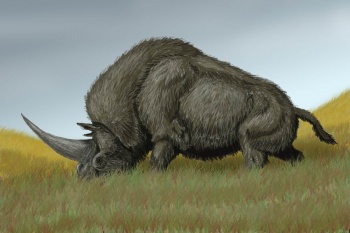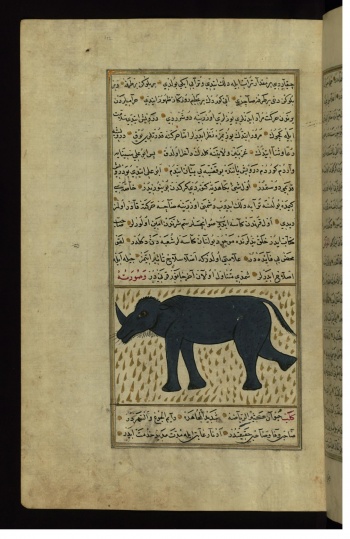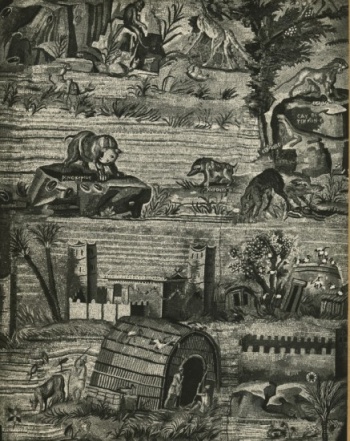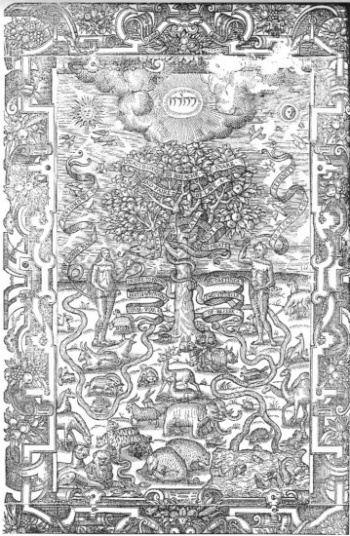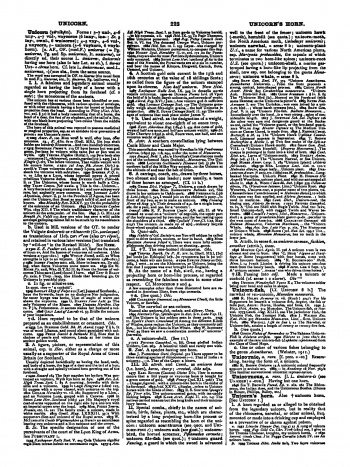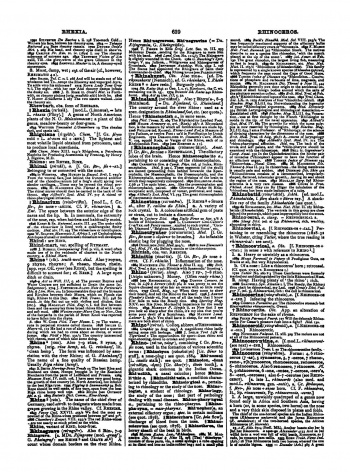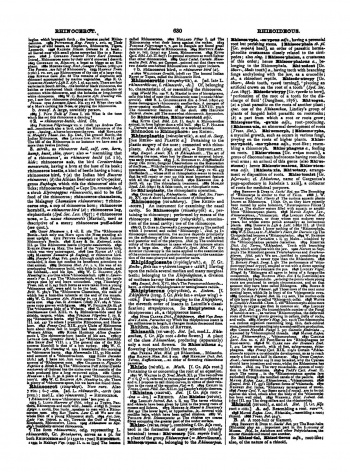Unicorn
From Textus Receptus
(→Foreign Language) |
(→Foreign Language) |
||
| Line 377: | Line 377: | ||
::[[1382 AD|1382]] '''<u>And vnycornes</u>''' schulen go doun with hem, and bolis with hem that ben myyti; the lond of hem schal be fillid with blood, and the erthe of hem with ynnere fatnesse of fatte beestis (Wycliffe Bible) | ::[[1382 AD|1382]] '''<u>And vnycornes</u>''' schulen go doun with hem, and bolis with hem that ben myyti; the lond of hem schal be fillid with blood, and the erthe of hem with ynnere fatnesse of fatte beestis (Wycliffe Bible) | ||
==Foreign Language== | ==Foreign Language== | ||
| + | |||
| + | ===Westminster Leningrad Codex 1008=== | ||
| + | * [[Numbers 23:22]] אֵ֖ל מֹוצִיאָ֣ם מִמִּצְרָ֑יִם כְּתֹועֲפֹ֥ת רְאֵ֖ם לֹֽו׃ ([[1008 AD|1008]]) | ||
| + | |||
| + | |||
| + | ===Greek Septuagint=== | ||
| + | ;Numbers 23:22 | ||
| + | |||
| + | ===Swete's Septuagint 1930=== | ||
| + | * [[Numbers 23:22]] θεὸς ὁ ἐξαγαγὼν αὐτοὺς ἐξ Αἰγύπτου· ὡς δόξα '''<u>μονοκέρωτος</u>''' αὐτῷ.([[1930 AD|1930]]) | ||
| + | |||
| + | * [[Numbers 24:8]] | ||
| + | |||
| + | |||
| + | ===Vulgata Clementina 1592=== | ||
| + | |||
| + | * [[Numbers 23:22]] Deus eduxit illum de Ægypto, cujus fortitudo similis est '''<u>rhinocerotis</u>'''. ([[1592 AD|1592]]) | ||
| + | |||
| + | * [[Numbers 24:8]] | ||
| + | |||
| + | ===Dutch Staten Vertaling 1637=== | ||
| + | |||
| + | God heeft hen uit Egypte uitgevoerd; zijn krachten zijn als van een '''<u>eenhoorn</u>'''. | ||
| + | |||
| + | ===French: Martin 1744=== | ||
| + | * [[Numbers 23:22]] Le [Dieu] Fort qui les a tirés d'Egypte, lui est comme les forces de la '''<u>Licorne</u>'''. (Nombres 23:22) ([[1744 AD|1744]]) | ||
| + | |||
| + | ===Spanish 1569=== | ||
| + | * [[Numbers 23:22]] Dios los ha sacado de Egipto; tiene fuerzas como de '''<u>unicornio</u>'''. ([[1569 AD|1569]]) | ||
| + | |||
| + | ===Spanish 1909=== | ||
| + | * [[Numbers 23:22]] Dios los ha sacado de Egipto; Tiene fuerzas como de '''<u>unicornio</u>'''. ([[1909 AD|1909]]) | ||
| + | |||
The Spanish RV 1909, has "unicorn" in [[Deuteronomy 14:5]] where the KJV has "[[Pygarg]]". All 9 other verses above also have unicorns in the Spanish RV 1909. | The Spanish RV 1909, has "unicorn" in [[Deuteronomy 14:5]] where the KJV has "[[Pygarg]]". All 9 other verses above also have unicorns in the Spanish RV 1909. | ||
Revision as of 13:04, 25 January 2023
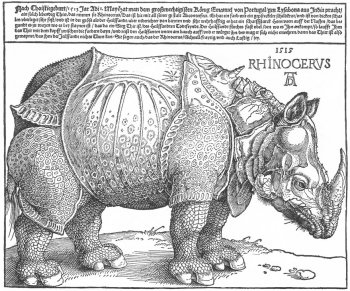

![The 1610 Douay Rheims with Rhinoceros in the main text and Unicorn in the margin [1].](/w/images/thumb/e/ec/1610_Douay_Rheims_Rhinoceros_Unicorn.jpg/350px-1610_Douay_Rheims_Rhinoceros_Unicorn.jpg)
The word Unicorn[4] in the King James Version is not a mythical creature as many have falsely assumed, but is most probably a type of Rhinoceros [5](or a similar creature) as stated in the margin of the original 1611 King James Bible in Isaiah 34:7 where it reads: “And the unicorns shall come down with them.” In the margin it says; “or Rhinocerots”, which was the exact English term for the Rhinoceros, in the 1611 era, derived from the Latin unicornis and the Greek μονόκερως (monokeros), both meaning “one-horned”, and both referring emphatically to a type of single horned Rhinoceros. The Hebrew word Re’em, also reëm (Hebrew: רְאֵם), mentioned nine times in the Hebrew Bible.
Modern textual critics make several false accusations against the scholarship of the King James translators in connection with this word.
Firstly, they claim that the translators either mistranslated the word unicorn or worse, assumed it to be a mythical horse like creature popular in European mythology.
Secondly, they falsely claim that Deuteronomy 33:17 in Hebrew speaks of the Re’em having two horns and not one.
Thirdly, they ignore the single horn reference in Psalm 92:10.
There is a massive amount of evidence against these false claims, including the historical precedence of the Greek Old Testament having μονόκερως (monókerōs, “having one horn”), and the Latin having Rhinocerotis five times and Unicornis four times. All English bibles predating 1611 have Unicorn in every place, except the Catholic Douay-Rheims Bible that has both Vnicorn and Rhinoceros. These massive evidences greatly support the King James Version reading of unicorn. The concept of another animal, such as a "wild-ox", "Auroch", or "goat" came after 1611, and was mostly popularized in modern bibles versions since around the time of Westcott and Hort’s Revised Version. The Oxford English Dictionary of 1910, and the Webster's Dictionary of 1828, both support the word unicorn as being an umbrella term for all kinds of creatures with a single horn, including the Rhinoceros. The footnote in the KJV modified which kind of unicorn it was, i.e., not a Narwal, nor the Hercules beetle, nor a mythical creature, nor a caterpillar (Schizura unicornis), nor a kamichi (unicorn bird), nor a snake (Green unicorn), nor a Rhino-horned lizard, nor a Bicornus (two horned) Rhinoceros, but a single horned "Rhinocerots", which was later officially named the Rhinoceros Unicornis.
Indian Rhinoceros
Rhinoceros Unicornis is the scientific name for the Indian Rhinoceros or the Great One-horned Rhinoceros or the Asian One-horned Rhinoceros which is is a large mammal found in Nepal, Bhutan, Pakistan and in Assam, India. It is confined to the tall grasslands and forests in the foothills of the Himalayas. The Indian Rhinoceros can run at speeds of up to 55 km/h for short periods of time and is also an excellent swimmer. It has excellent senses of hearing and smell, but relatively poor eyesight.
In the 3rd century, Philip the Arab exhibited an Indian rhinoceros in Rome. In 1515, Manuel I of Portugal obtained an Indian rhinoceros as a gift, which he passed on to Pope Leo X, but which died on the way from Lisbon to Rome. Three artistic representations were prepared of this rhinoceros: A woodcut by Hans Burgkmair, a drawing and a woodcut by Albrecht Dürer, all dated 1515. The Rhinoceros was sent as a present from the King of Portugal, Manuel I, to Pope Leo X in 1515, and this rhino died in a shipwreck off the coast of Italy in early 1516, and it was immortalised as Dürer's Rhinoceros in the woodcut. In 1577–1588, Abada was a female Indian rhinoceros kept by the Portuguese kings Sebastian I and Henry I from 1577 to 1580 and by Philip II of Spain from about 1580 to 1588. She was the first rhinoceros seen in Europe after Dürer's Rhinoceros. In about 1684, the first presumably Indian rhinoceros arrived in England.
In 1741–1758, Clara the rhinoceros (c. 1738 – 14 April 1758) was a female Indian rhinoceros who became famous during 17 years of touring Europe in the mid-18th century. She arrived in Europe in Rotterdam in 1741, becoming the fifth living rhinoceros to be seen in Europe in modern times since Dürer's Rhinoceros in 1515. After tours through towns in the Dutch Republic, the Holy Roman Empire, Switzerland, the Polish–Lithuanian Commonwealth, France, the Kingdom of the Two Sicilies, the Papal States, Bohemia and Denmark, she died in Lambeth, England. In 1739, she was drawn and engraved by two English artists. It was then brought to Amsterdam, where Jan Wandelaar made two engravings that were published in 1747. In the subsequent years, the rhinoceros was exhibited in several European cities. In 1748, Johann Elias Ridinger made an etching of it in Augsburg, and Petrus Camper modelled it in clay in Leiden. In 1749, Georges-Louis Leclerc, Comte de Buffon drew it in Paris. In 1751, Pietro Longhi painted it in Venice.
Elasmotherium
The now extinct Elasmotherium (Elasmotherium sibiricum), "Giant Unicorn", had many features of a modern rhinoceros except it grew up up 2.7 metres (8.9 ft) high and 6 metres (20 ft) long and was very woolly. The animal may have weighed up to 7 tonnes (7.7 short tons). Its legs were longer than those of other rhinos and were designed for galloping, giving it a horse-like gait. It was probably a fast runner, in spite of its size. Its teeth were similar to those of horses, and it probably grazed low herbs.
While many evolutionists parrot Darwins false claims that man did not walk with dinosaurs, the bible and archaeology easily disprove this.
Karkadann
Another similar option is the the Karkadann (English: Rhinoceros, Persian: كرگدن "Lord of the Desert") which was a mythical unicorn-like creature said to live on the grassy plains of India, Persia and North Africa. The creature was quite similar to a rhinoceros. Upon its horn was an engraving with the head of a man.
An early description of the karkadann comes from the 10/11th century Persian scholar Abū Rayḥān al-Bīrūnī (Al-Biruni, 973–1048). He describes an animal which has "the build of a buffalo...a black, scaly skin; a dewlap hanging down under the skin. It has three yellow hooves on each foot...The tail is not long. The eyes lie low, farther down the cheek than is the case with all other animals. On the top of the nose there is a single horn which is bent upwards." A fragment of Al-Biruni preserved in the work of another author adds a few more characteristics: "the horn is conical, bent back towards the head, and longer than a span...the animal's ears protrude on both sides like those of a donkey, and...its upper lip forms into a finger-shape, like the protrusion on the end of an elephant's trunk." The Persian language uses the same word, karkadann, for the mythological animal as it does for the rhinoceros.
Ibn Battuta in his travelogue, calls the rhinoceros he saw in India karkadann. The karkadann was an extremely ferocious beast, driving away from its territory animals as big as the elephant. It is said it would fight an elephant and kill it. It would then hoist it above its head in triumph using its horn, before going blind as the elephant's fat flowed into its eyes as it melted in the sun.
The name karkadann is a variation of the Sanskrit kartajan, which means "lord of the desert". Other spellings and pronunciations include karkadan, kargadan, karmadan, and Cartazoon.
Palestrina mosaic
This Roman mosaic from the first century AD is found in the Museo Archeologico of Palestrina north of Rome. The African rhino is found in the left middle on a rock under which the name is written in Greek.
Persian Bestiarium
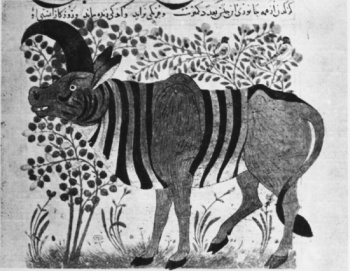
This Persian miniature was discovered in the Pierpont Morgan Library in New York. It is indicative of the earliest descriptions of a rhinoceros. Ctesias called it a wild ass resembling a horse with hoofed feet. Aristotle called it the monoceros and the Greek geographer Strabo called it the rhinoceros.
Rabbai Kimche
R. Dovid Kimche (1160 - 1235), in his dictionary of the Hebrew language called Sefer Hashorashim, wrote that the re'em has only one horn.
Abraham Yagel
Abraham Yagel, (1553 – 1623), the Italian rabbi and exegete, mentioned a one-horned re'em that had been captured and brought to Portugal:
- Book IV, ch. 45: 108a בית יער הלבנון
ובימנו הובא בארץ פורטוגאלי מן האי האינדי׳ ראם אחד במצודה צדו אותו ומראה צורתו הביאו אח׳כ עוברי אורחות ימים והוא גדול מהפיל ומזרין: בקסקשיו בכל עורו וקרן חזות עב על חוטמו אשר בו לחם מלחמות עם הפיל ועם שאר החיות
- And in our days a re'em was brought to Portugal from India having been ambushed and trapped, and afterwards sea travellers reported how it looked. It is larger than an elephant and its scales cover all its skin. It has a thick horn on its nose which it uses in fights with the elephant and with other creatures...
As Natan Slifkin points out, what Yagel what was actually describing was a rhinoceros: "It was given to King Manuel of Portugal by Alfonso de Albuquerque, governor of Portuguese India. This was the first rhinoceros to be brought to Europe since Roman times, and it caused quite a sensation."
Besides the King James Version the following also use the word Unicorn or a foreign language equivilant.
The Latin Vulgate
Jerome in the 4th century translated the Hebrew word Reem as Rhinocerotis five times and Unicornis four times. Jerome studied Hebrew under the Jews before he began his translation of the Old Testament, thus it is from the Jews directly that Jerome derived his definitions.
Marco Polo
The unicorn, tamable only by a virgin woman, was well established in medieval lore by the time Marco Polo described them as "scarcely smaller than elephants. They have the hair of a buffalo and feet like an elephant's. They have a single large black horn in the middle of the forehead... They have a head like a wild boar's… They spend their time by preference wallowing in mud and slime. They are very ugly brutes to look at. They are not at all such as we describe them when we relate that they let themselves be captured by virgins, but clean contrary to our notions."
The Septuagint
The Septuagint has μονόκερως (monókerōs, “having one horn”), for the Hebrew רְאֵם re'em.
In Deuteronomy 33:17, Lancelot Brenton’s 1851 English translation of the Septuagint has “unicorn” [singular] as does Henry Howard‘s 1857 English translation of the Pentateuch of the LXX. The 1569 Spanish Bible and 1602 Spanish Valera has unicornio [singular] at this verse.
Correct Definitions
Pliny the Elder (First century AD)
- “an exceedingly wild beast called the Monoceros (one - horned)...It makes a deep lowing noise, and one black horn two cubits long projects from the middle of its forehead. This animal, they say, cannot be taken alive.”
Aristotle
- “I have found that wild asses as large as horses are to be found in India. It has a horn on the brow, about one cubit and a half in length..”
Middle English Definitions
(a1398) *Trev.Barth.(Add 27944)296b/b : [6]
- Rinoceron [L Rinoceron], þe vnycorne, is a wilde beste by kynde and may be y-tamed by no wyse.
(a1398) *Trev.Barth.(Add 27944)297a/a :
- Þer ben many kyndes of vnycorne, ffor some ben rinoceron and some monoceron and egliceron.
c1400(?a1300) KAlex.(LdMisc 622)6519 :
- Anoþere beeste..þere is Þat hat rinoceros [LinI: rinocertis]..Jt is more þan an olifaunt; Jn þe wilde wood is his haunt..For on his snoute an horne he beres Þat he sleeþ wiþ lyouns and beres.
(a1460) DSPhilos.(Helm)113/36 :
- There bene somme cuntrees that a litil of the vnycornes boon or iuery is bought for a grete somme of golde and syluer.
Theodore Beza
Theodore Beze in 1608, depicted a two unicorns, an Indian Rhino, and a mythological Unicorn.
Douay Rheims
![The 1610 Douay Rheims with Rhinoceros in the main text and Unicorn in the margin [2].](/w/images/thumb/e/ec/1610_Douay_Rheims_Rhinoceros_Unicorn.jpg/350px-1610_Douay_Rheims_Rhinoceros_Unicorn.jpg)
The 1610 Douay-Rheims Bible bible has Rhinoceros in the main text at Job 39:9 with the marginal note:
- (e) Vnicornes
Pseudodoxia Epidemica
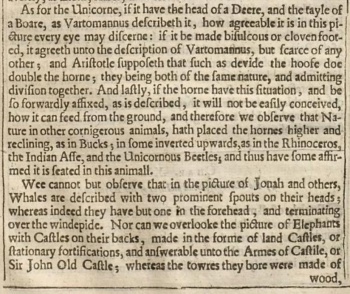
Pseudodoxia Epidemica Or, Enquiries Into Very Many Received Tenents, and Commonly Presumed Truths By Sir Thomas Browne, 1646:
An English Dictionary - E. Coles 1717
Unicornus, L. of one horn
Daniel Webster’s Dictionary of 1828
![Unicorn in Daniel Webster’s Dictionary of 1828 [3].](/w/images/thumb/d/d8/Unicorn_Daniel_Webster%E2%80%99s_Dictionary_of_1828.JPG/350px-Unicorn_Daniel_Webster%E2%80%99s_Dictionary_of_1828.JPG)
- n. L. unicornis; unus, one, and cornu, horn.]
- 1. an animal with one horn; the monoceros. this name is often applied to the rhinoceros.
- 2. The sea unicorn is a fish of the whale kind, called narwal, remarkable for a horn growing out at his nose.
- 3. A fowl. fossil unicorn, or fossil unicorn's horn, a substance used in medicine, a terrene crustaceous spar.
Treasury of Scripture Knowledge
- "The Reem, most probably denotes the Rhinoceros, so called from the horn on its nose. In size he is only exceeded by the elephant; and in strength and power inferior to none. He is at least twelve feet in length, from the snout to the tail; six or seven feet in height; and the circumference of the body is nearly equal to his length. He is particularly distinguished from all other animals by the remarkable and offensive weapon he carries on his nose; which is very hard horn, solid throughout, directed forward."
Jamieson-Fausset-Brown
- "Israel is not as they were at the Exodus, a horde of poor, feeble, spiritless people, but powerful and invincible as a Reem - that is, a Rhinoceros."
Wesley's Notes
- Numbers 23:22 Out of Egypt - Namely, by a strong hand, and in spite of all their enemies, and therefore it is in vain to seek or hope to overcome them. He - Israel, whom God brought out of Egypt, such change of numbers being very common in the Hebrew language. The sense is, Israel is not now what he was in Egypt, a poor, weak, dispirited, unarmed people, but high and strong and invincible. An unicorn - The word may mean either a rhinoceros, or a strong and fierce kind of wild goat. But such a creature as an unicorn, as commonly painted, has no existence in nature.
History of English Podcast
- The Latin word for one was unus from the same Indo-European root as one. And unus passed into English as the prefix uni- meaning one. This prefix was starting to pass into English in the early 1300s, and it gave English speakers a new way to indicate one-ness. The word unicorn is one of the first known words with that prefix to pass into English. It was actually used in the Ancrene Wisse because it was also used in the Bible. It was a direct translation of the Greek word monoceros which literally mean ‘one horn.’ Unicorn meant ‘one horn’ in Latin, and English actually used a direct translation of that word early on. English had the word as anhorn before the Latin unicorn won out. The next word with that prefix to enter English was the word university which is first attested in English at the current point in our overall story in the year 1300. [7]
Oxford English Dictionary
Incorrect Definitions
Defined King James Bible
The Defined King James Bible by D. A. Waite, included in its note concerning "unicorns" at Deuteronomy 33:17 the following:
- "Heb probably the great aurochs or wild bulls which are now extinct" (p. 315).
Waite quotes the O.E.D. p. 3512 definition 1.b. Used in Middle English versions of the OT. to render the Vulgate unicornis or rhinoceros (Gr. monoceros) and retained in various later versions. Waite adds this note at Deuteronomy 33:17; The exact meaning is not known. (This quote may be from an old version of the DKJB)
Trinitarian Bible Society
The Trinitarian Bible Society has published "A Bible Word List" which "gives brief explanations of words in the Authorised Version describing unfamiliar objects, animals and plants, weights, measures and money, and words no longer in everyday use, or now used with a different meaning." Under Unicorn it has:
Strong's Concordance
- or rieym {reh-ame'}; or reym {rame}; or rem {rame}; from 'ra'am' (7213); a wild bull (from its conspicuousness):--unicorn.
Easton's Bible Dictionary
- Described as an animal of great ferocity and strength (Numbers 23:22, R.V., "wild ox, " marg., "ox-antelope;24:8; Isaiah 34:7, R.V., "wild oxen"), and untamable (Job 39:9). It was in reality a two-horned animal; but the exact reference of the word so rendered (reem) is doubtful. Some have supposed it to be the buffalo; others, the white antelope, called by the Arabs rim. Most probably, however, the word denotes the Bos primigenius ("primitive ox"), which is now extinct all over the world. This was the auerochs of the Germans, and the urus described by Caesar (Galatians Bel., vi.28) as inhabiting the Hercynian forest. The word thus rendered has been found in an Assyrian inscription written over the wild ox or bison, which some also suppose to be the animal intended (Comp. Deuteronomy 33:17; Psalm 22:21; 29:6; 92:10).
International Standard Bible Encyclopedia
- u'-ni-korn (re'em (Numbers 23:22; Numbers 24:8 Deuteronomy 33:17 Job 39:9-10, Psalm 22:21; Psalm 29:6; Psalm 92:10 Isaiah 34:7)): "Unicorn" occurs in the King James Version in the passages cited, where the Revised Version (British and American) has "wild-ox" (which see).
Henry Morris
- “The Hebrew word translated unicorn is believed by most Hebrew scholars to refer to the huge and fierce aurochs, or wild ox now extinct.”
W. L. Alexander (Pulpit Commentary)
- “the reem is supposed to be the aurochs, an animal of the bovine species, allied to the buffalo, now extinct.”
Charles Spurgeon
- “The unicorn may have been some gigantic ox or buffalo now unknown and perhaps extinct.”
William Houghon
- “we think that there can be no doubt that some species of wild ox is intended.”
Sunday School Teachers’ Bible
The 1895 Sunday School Teachers’ Bible has:
- “The LXX translation has passed into our A. V., but is erroneous, as the mention of two horns on one reem (Deut. 33:17) proves.”
Scofield Reference Notes
for Numbers 23:22 Margin “unicorn i.e. the aurochs, or wild ox.”
Gustavus Paine
- “the mythical unicorn is found in nine Bible verses” (Men, p. 61).
John Worcester
- “the name ‘unicorn’ is a translator’s mistake” (Animals, p. 22).
Jay P. Green
Jay P. Green's A CONCISE LEXICON TO THE BIBLICAL LANGUAGES gave the meaning of this Hebrew word as "wild ox" (p. 213).
Barnes Commentary
- An unicorn - A wild bull, the now extinct Aurochs, formidable for its size, strength, speed, and ferocity.
Ronald Bridges and Luther Weigle
- “The mistaken rendering began with the Greek Septuagint, which used monokeros, and the Latin Vulgate, which used unicornis or rhinoceros” (KJB Word Book, p. 353).
Smith's Bible Dictionary
- the rendering of the Authorized Version of the Hebrew reem, a word which occurs seven times in the Old Testament as the name of some large wild animal. The reem of the Hebrew Bible, however, has nothing at all to do with the one-horned animal of the Greek and Roman writers, as is evident from De 33:17 where in the blessing of Joseph it is said; "his glory is like the firstling of his bullock, and his horns are like the horns of a unicorn;" not, as the text of the Authorized Version renders it, "the horns of unicorns." The two horns of the ram are "the ten thousands of Ephraim and the thousands of Manasseh." This text puts a one-horned animal entirely out of the question. Considering that the reem is spoken of as a two-horned animal of great strength and ferocity, that it was evidently well known and often seen by the Jews, that it is mentioned as an animal fit for sacrificial purposes, and that it is frequently associated with bulls and oxen we think there can be no doubt that, some species of wild ox is intended. The allusion in Ps 92:10 "But thou shalt lift up, as a reeym, my horn," seems to point to the mode in which the Bovidae use their horns, lowering the head and then tossing it up. But it is impossible to determine what particular species of wild ox is signified probably some gigantic urus is intended. (It is probable that it was the gigantic Bos primigeniua, or aurochs, now extinct, but of which Caesar says, "These uri are scarcely less than elephants in size, but in their nature, color and form are bulls. Great is their strength and great their speed; they spare neither man nor beast when once; they have caught sight of them" --Bell. Gall. vi. 20.- ED.)
Fausset's Bible Dictionary
- reem. In Deuteronomy 33:17, "his (Joseph's) horns are like the horns of an unicorn" (so margin rightly, not "unicorns"); "the ten thousands of Ephraim and the thousands of Manasseh," two tribes sprung from the one Joseph, are the two horns from one head. Therefore the unicorn was not as is represented a one-horned animal, but some species of urns or wild ox. The rhinoceros does not "skip" as the young unicorn is represented to do (Psalm 29:6). The unicorn's characteristics are: (1) great strength, Numbers 23:22; Job 39:11; (2) two horns, Deuteronomy 33:17; (3) fierceness, Psalm 22:21; (4) untameableness, Job 39:9-11, where the unicorn, probably the wild bison, buffalo, ox, or urus (now only found in Lithuania, but then spread over northern temperate climes, Bashan, etc., and in the Hercynian forest, described by Caesar as almost the size of an elephant, fierce, sparing neither man nor beast) stands in contrast to the tame ox used in plowing, Job 39:11-12; (5) playfulness of its young, Psalm 29:6; (6) association with "bullocks and bulls" for sacrifice, Isaiah 34:6-7; (7) lifting up the horn, Psalm 92:10, as bovine animals lower the head and toss up the horn.
Adam Clarke's Commentary
- The strength of a unicorn. — ראם reem and ראים reim. It is generally allowed that there is no such beast in nature as the unicorn; i. e., a creature of the horse kind, with one long rich curled horn in the forehead. The creature painted from fancy is represented as one of the supporters of the royal arms of Great Britain. It is difficult to say what kind of beast is intended by the original word. The Septuagint translate the word μονοκερως, the unicorn, or one-horned animal; the Vulgate, sometimes, unicornus; and in the text rhinocerotis, by which the rhinoceros, a creature which has its name from the horn on its nose, is supposed to be meant. That no single-horned animal can be intended by the reem of Moses, is sufficiently evident from this, that Moses, speaking of Joseph, says, "he has the HORNS of A unicorn," or reem, where the horns are spoken of in the plural, the animal in the singular. The creature referred to is either the rhinoceros, some varieties of which have two horns on the nose, or the wild bull, urus, or buffalo; though some think the beast intended is a species of goat; but the rhinoceros seems the most likely. There is literally a monoceros, or unicorn, with one large curled ivory horn growing horizontally out of his snout; but this is not a land animal, it is the modiodan or nurwal, a marine animal of the whale kind, a horn of which is now before me, measuring seven feet four inches; but I believe the rhinoceros is that intended by the sacred writers.
Unicorn in English Bibles
The Word Unicorn(s) appears 9 times in the KJV:
- 1568 God brought them out of Egypt, they haue strength as an Unicorne. (Bishops Bible)
- 1560 God brought them out of Egypt: their strength is as an vnicorne. (Geneva Bible)
- 1539 God brought them oute of Egypte, he hath strength as an vnicorne. (The Great Bible)
- 1537 God hath brought them out of Egypt is as the strength of an vnicorne vnto them, (Matthew's Bible)
- 1535 God hath brought the out of Egipte, his stregth is as of an Vnicorne. (Coverdale Bible)
- 1382 The Lord God ledde hym out of Egipt, whos strengthe is lijk an vnicorn; (Wycliffe Bible)
- Numbers 24:8 God brought him forth out of Egypt; he hath as it were the strength of an unicorn: he shall eat up the nations his enemies, and shall break their bones, and pierce them through with his arrows.
- 1568 God brought hym out of Egypt, his strength is as the Unicorne: He shall eate the nations his enemies, & gnawe their bones, and pearce them through with his arrowes. (Bishops Bible)
- 1560 God brought him out of Egypt: his strength shalbe as an vnicorne: he shall eate the nations his enemies, and bruise their bones, and shoote them through with his arrowes. (Geneva Bible)
- 1539 God broughte hym out of Egypt: as the strength of an vnycorne is he vnto hym. He shall eate the nacyons hys enemyes, and gnawe theyr bones, & perce them thorowe with his arowes. (The Great Bible)
- 1537 God that brought him out of Egipt his strength is as the strengthe of an vnicorne, & he shal eate the nations that are hys enemies & breake theyr bones, and perce them thorowe wyth hys arrowes. (Matthew's Bible)
- 1535 God hath broughte hi out of Egipte, his strength is as of an vnicorne. He shal eate vp the Heithen his enemies, and grynde their bones to poulder, and shute thorow them with his arowes. (Coverdale Bible)
- 1382 God ledde hym out of Egipt, whos strengthe is lijk an vnicorn; thei schulen deuoure hethene men, enemyes `of hym, that is, of Israel; and thei schulen breke the boonus of hem, and schulen perse with arowis. (Wycliffe Bible)
- Deuteronomy 33:17 His glory is like the firstling of his bullock, and his horns are like the horns of unicorns: with them he shall push the people together to the ends of the earth: and they are the ten thousands of Ephraim, and they are the thousands of Manasseh.
- 1568 His first borne oxe hath beautie, and his hornes are as the hornes of an vnicorne, and with them he shall trouble the nations together, euen vnto the endes of the worlde: These are also ten thousandes of Ephraim, and the thousandes of Manasses (Bishops Bible)
- 1560 His beautie shalbe like his first borne bullock, and his hornes as the hornes of an vnicorne: with them hee shall smite the people together, euen the endes of the world: these are also the ten thousands of Ephraim, and these are the thousands of Manasseh (Geneva Bible)
- 1539 his firstborne oxe hath be wtie, and his hornes are as the hornes of an vnycorne. And wyth them he shall trouble the nacyons together, euen vnto the endes of the worlde. These are also the many thousandes of Ephraim, & the thousandes of Manasses. (The Great Bible)
- 1537 his beutye is as fyrsteborne oxe and hys hornes as the hornes of an vnycorne. And wyth them he shal push the nations togyther, euen vnto the endes of the world. These are the many thousandes of Ephraim and the thousandes of Manasses. (Matthew's Bible)
- 1535 His bewtye is as a firstborne oxe, and his hornes are as ye hornes of an Vnicorne: with the same shal he pusshe the nacions together, euen vnto the endes of the worlde. These are the thousandes of Ephraim, and the thousandes of Manasse. (Coverdale Bible)
- 1382 As the first gendrid of a bole is the feirnesse of hym; the hornes of an vnicorn ben the hornes of hym; in tho he schal wyndewe folkis, `til to the termes of erthe. These ben the multitudis of Effraym, and these ben the thousyndis of Manasses. (Wycliffe Bible)
- Job 39:9 Will the unicorn be willing to serve thee, or abide by thy crib?
- 1568 Wyll the vnicorne do thee seruice, or abide still by thy cribbe. (Bishops Bible)
- 1560 Will the vnicorne serue thee? or will he tary by thy cribbe? (Geneva Bible) (Marked as verse 12 in some editions)
- 1539 Wyll the vnycorne be so tame as to do the seruice, or to abyde styll by thy crybbe? (The Great Bible)
- 1537 Whyl the vnicorne be so tame as to do the seruyce, or to abyde styl by thy cryb? (Matthew's Bible)
- 1535 Wyll the vnicorne be so tame as to do ye seruyce, or to abyde still by thy cribbe? (Coverdale Bible)
- 1382 Whether an vnycorn schal wilne serue thee, ethir schal dwelle at thi cratche? (Wycliffe Bible)
- Job 39:10 Canst thou bind the unicorn with his band in the furrow? or will he harrow the valleys after thee?
- 1568 Canst thou binde the yoke about the vnicorne in the forowe, to make him plowe after thee in the valleyes (Bishops Bible)
- 1560 Canst thou binde the vnicorne with his band to labour in the furrowe? or will he plowe the valleyes after thee? (Geneva Bible) (Marked as verse 13 in some editions)
- 1539 Canst thou bynd the yock about the vnycorne in thy forowe, to make hym plowe after the in the valleys? (The Great Bible)
- 1537 Canste thou bynd the yocke about him in thy sorowes, to make him plowe after the in the valleys? (Matthew's Bible)
- 1535 Cast thou bynde ye yock aboute him in thy forowes, to make him plowe after the in ye valleis? (Coverdale Bible)
- 1382 Whether thou schalt bynde the vnicorn with thi chayne, for to ere, ethir schal he breke the clottis of valeis aftir thee? (Wycliffe Bible)
- Psalm 22:21 Save me from the lion’s mouth: for thou hast heard me from the horns of the unicorns.
- 1568 Saue me from the Lions mouth: delyuer me from the hornes of the Unicornes. (Bishops Bible)
- 1560 Saue me from the lyons mouth, and answere me in sauing me from the hornes of the vnicornes. (Geneva Bible)
- 1539 Saue me from the lyons mouth: thou hast hearde me also from amonge the hornes of the vnicornes. (The Great Bible)
- 1537 Saue me from the Lyons mouth, & heare me from amonge the hornes of the Vnicornes. (Matthew's Bible)
- 1535 Saue me from the lyons mouth, and heare me fro amonge the hornes off the vnicornes. (Coverdale Bible)
- 1382 (Available but hard to source) (Wycliffe Bible)
- Psalm 29:6 He maketh them also to skip like a calf; Lebanon and Sirion like a young unicorn.
- 1568 And he maketh them to skip like a calfe: Libanus also and Sirion like a young vnicorne (Bishops Bible)
- 1560 He maketh them also to leape like a calfe: Lebanon also and Shirion like a yong vnicorne. (Geneva Bible)
- 1539 He maketh them to skyppe lyke a calfe: Libanus and Sirion lyke a younge vnicorne (The Great Bible)
- 1537 He maketh them to skyppe lyke a calfe: Libanus and Sirion lyke a younge vnicorne (Matthew's Bible)
- 1535 He maketh them to skippe like a calfe: Libanus and Sirion like a yonge vnycorne. (Coverdale Bible)
- 1382 And he schal al to-breke hem to dust as a calf of the Liban; and the derling was as the sone of an vnycorn. (Wycliffe Bible)
- Psalm 92:10 But my horn shalt thou exalt like the horn of an unicorn: I shall be anointed with fresh oil.
- 1568 But my horne shalbe exalted lyke the horne of an vnicorne: for I am annoynted with excellent oyle (Bishops Bible)
- 1560 But thou shalt exalt mine horne, like the vnicornes, and I shalbe anoynted with fresh oyle. (Geneva Bible)
- 1539 But my horne shalbe exalted like the horne of an Unicorne, for I am anoynted with fresh oyle. (The Great Bible)
- 1537 But my horne shalbe exalted like the horne of an Vnicorne, & shalbe anoynted wyth fresh oyle. (Matthew's Bible)
- 1535 But my horne shalbe exalted like the horne of an Vnicorne, & shal be anoynted with fresh oyle. (Coverdale Bible)
- 1382 And myn horn schal be reisid as an vnicorn; and myn eelde in plenteuouse merci. (Wycliffe Bible)

- Isaiah 34:7 And the unicorns shall come down with them, and the bullocks with the bulls; and their land shall be soaked with blood, and their dust made fat with fatness.
- 1568 There shall the vnicornes fall with them, and the bulles with the giauntes, and their lande shalbe throughly soked with blood, and their grounde corrupt with fatnesse (Bishops Bible)
- 1560 And the vnicorne shall come downe with them and the heiffers with the bulles, and their lande shalbe drunken with blood, and their dust made fat with fatnesse. (Geneva Bible)
- 1539 There shall the vnicornes fall wt them, and the bulles wt the gyauntes: and their lande shalbe thorowely soaked with bloude, & their grounde corrupt with fatnes. (The Great Bible)
- 1537 There shall the Vnycornes fall with the Bulles (that is with the gyauntes) and theyr lande shalbe washed wyth bloude, and their grounde corrupte wyth fatnesse. (Matthew's Bible)
- 1535 There shal the Vnicornes fall with the Bulles, (that is with the giauntes) and their londe shalbe washed with bloude, & their grounde corrupte with fatnesse (Coverdale Bible)
- 1382 And vnycornes schulen go doun with hem, and bolis with hem that ben myyti; the lond of hem schal be fillid with blood, and the erthe of hem with ynnere fatnesse of fatte beestis (Wycliffe Bible)
Foreign Language
Westminster Leningrad Codex 1008
- Numbers 23:22 אֵ֖ל מֹוצִיאָ֣ם מִמִּצְרָ֑יִם כְּתֹועֲפֹ֥ת רְאֵ֖ם לֹֽו׃ (1008)
Greek Septuagint
- Numbers 23
- 22
Swete's Septuagint 1930
- Numbers 23:22 θεὸς ὁ ἐξαγαγὼν αὐτοὺς ἐξ Αἰγύπτου· ὡς δόξα μονοκέρωτος αὐτῷ.(1930)
Vulgata Clementina 1592
- Numbers 23:22 Deus eduxit illum de Ægypto, cujus fortitudo similis est rhinocerotis. (1592)
Dutch Staten Vertaling 1637
God heeft hen uit Egypte uitgevoerd; zijn krachten zijn als van een eenhoorn.
French: Martin 1744
- Numbers 23:22 Le [Dieu] Fort qui les a tirés d'Egypte, lui est comme les forces de la Licorne. (Nombres 23:22) (1744)
Spanish 1569
- Numbers 23:22 Dios los ha sacado de Egipto; tiene fuerzas como de unicornio. (1569)
Spanish 1909
- Numbers 23:22 Dios los ha sacado de Egipto; Tiene fuerzas como de unicornio. (1909)
The Spanish RV 1909, has "unicorn" in Deuteronomy 14:5 where the KJV has "Pygarg". All 9 other verses above also have unicorns in the Spanish RV 1909.
External Links
- Videos
- Articles
- Unicorns by Will Kinney
- “Unicorn” or “Wild oxen” in Numbers 23:22 et al.? by KJV Today
- Unicorns in the Bible by Answers in Genesis
- Wikipedia article on the Indian Rhinoceros
- Wikipedia article on Rhinoceros
Critical of the KJV
- Mythological and Mysterious Creatures in the KJV Unicorns by Brian Tegart
- Unicorns and the KJV by Rick Norris
- The Unicorn: the Bible does not refer to fantasy creatures by Creation Ministries International
- Why I Believe in Unicorns Video explains that the use of Unicorn is correct, but fails to mention the generalizing use of the singular noun, in which case a singular noun could give the sense of the plural

|
![]() 1 ·
1 ·
![]() 2 ·
2 ·
![]() 3 ·
3 ·
![]() 4 ·
4 ·
![]() 5 ·
5 ·
![]() 6 ·
6 ·
![]() 7 ·
7 ·
![]() 8 ·
8 ·
![]() 9 ·
9 ·
![]() 10 ·
10 ·
![]() 11 ·
11 ·
![]() 12 ·
12 ·
![]() 13 ·
13 ·
![]() 14 ·
14 ·
![]() 15 ·
15 ·
![]() 16 ·
16 ·
![]() 17 ·
17 ·
![]() 18 ·
18 ·
![]() 19 ·
19 ·
![]() 20 ·
20 ·
![]() 21 ·
21 ·
![]() 22 ·
22 ·
![]() 23 ·
23 ·
![]() 24 ·
24 ·
![]() 25 ·
25 ·
![]() 26 ·
26 ·
![]() 27 ·
27 ·
![]() 28 ·
28 ·
![]() 29 ·
29 ·
![]() 30 ·
30 ·
![]() 31 ·
31 ·
![]() 32 ·
32 ·
![]() 33 ·
33 ·
![]() 34 ·
34 ·
![]() 35 ·
35 ·
![]() 36 ·
36 ·
![]() 37 ·
37 ·
![]() 38 ·
38 ·
![]() 39 ·
39 ·
![]() 40 ·
40 ·
![]() 41 ·
41 ·
![]() 42 ·
42 ·
![]() 43 ·
43 ·
![]() 44 ·
44 ·
![]() 45 ·
45 ·
![]() 46 ·
46 ·
![]() 47 ·
47 ·
![]() 48 ·
48 ·
![]() 49 ·
49 ·
![]() 50 ·
50 ·
![]() 51 ·
51 ·
![]() 52 ·
52 ·
![]() 53 ·
53 ·
![]() 54 ·
54 ·
![]() 55 ·
55 ·
![]() 56 ·
56 ·
![]() 57 ·
57 ·
![]() 58 ·
58 ·
![]() 59 ·
59 ·
![]() 60 ·
60 ·
![]() 61 ·
61 ·
![]() 62 ·
62 ·
![]() 63 ·
63 ·
![]() 64 ·
64 ·
![]() 65 ·
65 ·
![]() 66 ·
66 ·
![]() 67 ·
67 ·
![]() 68 ·
68 ·
![]() 69 ·
69 ·
![]() 70 ·
70 ·
![]() 71 ·
71 ·
![]() 72 ·
72 ·
![]() 73 ·
73 ·
![]() 74 ·
74 ·
![]() 75 ·
75 ·
![]() 76 ·
76 ·
![]() 77 ·
77 ·
![]() 78 ·
78 ·
![]() 79 ·
79 ·
![]() 80 ·
80 ·
![]() 81 ·
81 ·
![]() 82 ·
82 ·
![]() 83 ·
83 ·
![]() 84 ·
84 ·
![]() 85 ·
85 ·
![]() 86 ·
86 ·
![]() 87 ·
87 ·
![]() 88 ·
88 ·
![]() 89 ·
89 ·
![]() 90 ·
90 ·
![]() 91 ·
91 ·
![]() 92 ·
92 ·
![]() 93 ·
93 ·
![]() 94 ·
94 ·
![]() 95 ·
95 ·
![]() 96 ·
96 ·
![]() 97 ·
97 ·
![]() 98 ·
98 ·
![]() 99 ·
99 ·
![]() 100 ·
100 ·
![]() 101 ·
101 ·
![]() 102 ·
102 ·
![]() 103 ·
103 ·
![]() 104 ·
104 ·
![]() 105 ·
105 ·
![]() 106 ·
106 ·
![]() 107 ·
107 ·
![]() 108 ·
108 ·
![]() 109 ·
109 ·
![]() 110 ·
110 ·
![]() 111 ·
111 ·
![]() 112 ·
112 ·
![]() 113 ·
113 ·
![]() 114 ·
114 ·
![]() 115 ·
115 ·
![]() 116 ·
116 ·
![]() 117 ·
117 ·
![]() 118 ·
118 ·
![]() 119 ·
119 ·
![]() 120 ·
120 ·
![]() 121 ·
121 ·
![]() 122 ·
122 ·
![]() 123 ·
123 ·
![]() 124 ·
124 ·
![]() 125 ·
125 ·
![]() 126 ·
126 ·
![]() 127 ·
127 ·
![]() 128 ·
128 ·
![]() 129 ·
129 ·
![]() 130 ·
130 ·
![]() 131 ·
131 ·
![]() 132 ·
132 ·
![]() 133 ·
133 ·
![]() 134 ·
134 ·
![]() 135 ·
135 ·
![]() 136 ·
136 ·
![]() 137 ·
137 ·
![]() 138 ·
138 ·
![]() 139 ·
139 ·
![]() 140 ·
140 ·
List of New Testament minuscules
1 · 2 · 3 · 4 · 5 · 6 · 7 · 8 · 9 · 10 · 11 · 12 · 13 · 14 · 15 · 16 · 17 · 18 · 19 · 20 · 21 · 22 · 23 · 24 · 25 · 26 · 27 · 28 · 29 · 30 · 31 · 32 · 33 · 34 · 35 · 36 · 37 · 38 · 39 · 40 · 41 · 42 · 43 · 44 · 45 · 46 · 47 · 48 · 49 · 50 · 51 · 52 · 53 · 54 · 55 · 56 · 57 · 58 · 59 · 60 · 61 · 62 · 63 · 64 · 65 · 66 · 67 · 68 · 69 · 70 · 71 · 72 · 73 · 74 · 75 · 76 · 77 · 78 · 79 · 80 · 81 · 82 · 83 · 84 · 85 · 86 · 87 · 88 · 89 · 90 · 91 · 92 · 93 · 94 · 95 · 96 · 97 · 98 · 99 · 100 · 101 · 102 · 103 · 104 · 105 · 106 · 107 · 108 · 109 · 110 · 111 · 112 · 113 · 114 · 115 · 116 · 117 · 118 · 119 · 120 · 121 · 122 · 123 · 124 · 125 · 126 · 127 · 128 · 129 · 130 · 131 · 132 · 133 · 134 · 135 · 136 · 137 · 138 · 139 · 140 · 141 · 142 · 143 · 144 · 145 · 146 · 147 · 148 · 149 · 150 · 151 · 152 · 153 · 154 · 155 · 156 · 157 · 158 · 159 · 160 · 161 · 162 · 163 · 164 · 165 · 166 · 167 · 168 · 169 · 170 · 171 · 172 · 173 · 174 · 175 · 176 · 177 · 178 · 179 · 180 · 181 · 182 · 183 · 184 · 185 · 186 · 187 · 188 · 189 · 190 · 191 · 192 · 193 · 194 · 195 · 196 · 197 · 198 · 199 · 200 · 201 · 202 · 203 · 204 · 205 · 206 · 207 · 208 · 209 · 210 · 211 · 212 · 213 · 214 · 215 · 216 · 217 · 218 · 219 · 220 · 221 · 222 · 223 · 224 · 225 · 226 · 227 · 228 · 229 · 230 · 231 · 232 · 233 · 234 · 235 · 236 · 237 · 238 · 239 · 240 · 241 · 242 · 243 · 244 · 245 · 246 · 247 · 248 · 249 · 250 · 251 · 252 · 253 · 254 · 255 · 256 · 257 · 258 · 259 · 260 · 261 · 262 · 263 · 264 · 265 · 266 · 267 · 268 · 269 · 270 · 271 · 272 · 273 · 274 · 275 · 276 · 277 · 278 · 279 · 280 · 281 · 282 · 283 · 284 · 285 · 286 · 287 · 288 · 289 · 290 · 291 · 292 · 293 · 294 · 295 · 296 · 297 · 298 · 299 · 300 · 301 · 302 · 303 · 304 · 305 · 306 · 307 · 308 · 309 · 310 · 311 · 312 · 313 · 314 · 315 · 316 · 317 · 318 · 319 · 320 · 321 · 322 · 323 · 324 · 325 · 326 · 327 · 328 · 329 · 330 · 331 · 332 · 333 · 334 · 335 · 336 · 337 · 338 · 339 · 340 · 341 · 342 · 343 · 344 · 345 · 346 · 347 · 348 · 349 · 350 · 351 · 352 · 353 · 354 · 355 · 356 · 357 · 358 · 359 · 360 · 361 · 362 · 363 · 364 · 365 · 366 · 367 · 368 · 369 · 370 · 371 · 372 · 373 · 374 · 375 · 376 · 377 · 378 · 379 · 380 · 381 · 382 · 383 · 384 · 385 · 386 · 387 · 388 · 389 · 390 · 391 · 392 · 393 · 394 · 395 · 396 · 397 · 398 · 399 · 400 · 401 · 402 · 403 · 404 · 405 · 406 · 407 · 408 · 409 · 410 · 411 · 412 · 413 · 414 · 415 · 416 · 417 · 418 · 419 · 420 · 421 · 422 · 423 · 424 · 425 · 426 · 427 · 428 · 429 · 430 · 431 · 432 · 433 · 434 · 435 · 436 · 437 · 438 · 439 · 440 · 441 · 442 · 443 · 444 · 445 · 446 · 447 · 448 · 449 · 450 · 451 · 452 · 453 · 454 · 455 · 456 · 457 · 458 · 459 · 460 · 461 · 462 · 463 · 464 · 465 · 466 · 467 · 468 · 469 · 470 · 471 · 472 · 473 · 474 · 475 · 476 · 477 · 478 · 479 · 480 · 481 · 482 · 483 · 484 · 485 · 486 · 487 · 488 · 489 · 490 · 491 · 492 · 493 · 494 · 495 · 496 · 497 · 498 · 499 · 500 · 501 · 502 · 503 · 504 · 505 · 506 · 507 · 543 · 544 · 565 · 566 · 579 · 585 · 614 · 639 · 653 · 654 · 655 · 656 · 657 · 658 · 659 · 660 · 661 · 669 · 676 · 685 · 700 · 798 · 823 · 824 · 825 · 826 · 827 · 828 · 829 · 830 · 831 · 876 · 891 · 892 · 893 · 1071 · 1143 · 1152 · 1241 · 1253 · 1423 · 1424 · 1432 · 1582 · 1739 · 1780 · 1813 · 1834 · 2050 · 2053 · 2059 · 2060 · 2061 · 2062 · 2174 · 2268 · 2344 · 2423 · 2427 · 2437 · 2444 · 2445 · 2446 · 2460 · 2464 · 2491 · 2495 · 2612 · 2613 · 2614 · 2615 · 2616 · 2641 · 2754 · 2755 · 2756 · 2757 · 2766 · 2767 · 2768 · 2793 · 2802 · 2803 · 2804 · 2805 · 2806 · 2807 · 2808 · 2809 · 2810 · 2811 · 2812 · 2813 · 2814 · 2815 · 2816 · 2817 · 2818 · 2819 · 2820 · 2821 · 2855 · 2856 · 2857 · 2858 · 2859 · 2860 · 2861 · 2862 · 2863 · 2881 · 2882 · 2907 · 2965 ·
01 · 02 · 03 · 04 · 05 · 06 · 07 · 08 · 09 · 010 · 011 · 012 · 013 · 014 · 015 · 016 · 017 · 018 · 019 · 020 · 021 · 022 · 023 · 024 · 025 · 026 · 027 · 028 · 029 · 030 · 031 · 032 · 033 · 034 · 035 · 036 · 037 · 038 · 039 · 040 · 041 · 042 · 043 · 044 · 045 · 046 · 047 · 048 · 049 · 050 · 051 · 052 · 053 · 054 · 055 · 056 · 057 · 058 · 059 · 060 · 061 · 062 · 063 · 064 · 065 · 066 · 067 · 068 · 069 · 070 · 071 · 072 · 073 · 074 · 075 · 076 · 077 · 078 · 079 · 080 · 081 · 082 · 083 · 084 · 085 · 086 · 087 · 088 · 089 · 090 · 091 · 092 · 093 · 094 · 095 · 096 · 097 · 098 · 099 · 0100 · 0101 · 0102 · 0103 · 0104 · 0105 · 0106 · 0107 · 0108 · 0109 · 0110 · 0111 · 0112 · 0113 · 0114 · 0115 · 0116 · 0117 · 0118 · 0119 · 0120 · 0121 · 0122 · 0123 · 0124 · 0125 · 0126 · 0127 · 0128 · 0129 · 0130 · 0131 · 0132 · 0134 · 0135 · 0136 · 0137 · 0138 · 0139 · 0140 · 0141 · 0142 · 0143 · 0144 · 0145 · 0146 · 0147 · 0148 · 0149 · 0150 · 0151 · 0152 · 0153 · 0154 · 0155 · 0156 · 0157 · 0158 · 0159 · 0160 · 0161 · 0162 · 0163 · 0164 · 0165 · 0166 · 0167 · 0168 · 0169 · 0170 · 0171 · 0172 · 0173 · 0174 · 0175 · 0176 · 0177 · 0178 · 0179 · 0180 · 0181 · 0182 · 0183 · 0184 · 0185 · 0186 · 0187 · 0188 · 0189 · 0190 · 0191 · 0192 · 0193 · 0194 · 0195 · 0196 · 0197 · 0198 · 0199 · 0200 · 0201 · 0202 · 0203 · 0204 · 0205 · 0206 · 0207 · 0208 · 0209 · 0210 · 0211 · 0212 · 0213 · 0214 · 0215 · 0216 · 0217 · 0218 · 0219 · 0220 · 0221 · 0222 · 0223 · 0224 · 0225 · 0226 · 0227 · 0228 · 0229 · 0230 · 0231 · 0232 · 0234 · 0235 · 0236 · 0237 · 0238 · 0239 · 0240 · 0241 · 0242 · 0243 · 0244 · 0245 · 0246 · 0247 · 0248 · 0249 · 0250 · 0251 · 0252 · 0253 · 0254 · 0255 · 0256 · 0257 · 0258 · 0259 · 0260 · 0261 · 0262 · 0263 · 0264 · 0265 · 0266 · 0267 · 0268 · 0269 · 0270 · 0271 · 0272 · 0273 · 0274 · 0275 · 0276 · 0277 · 0278 · 0279 · 0280 · 0281 · 0282 · 0283 · 0284 · 0285 · 0286 · 0287 · 0288 · 0289 · 0290 · 0291 · 0292 · 0293 · 0294 · 0295 · 0296 · 0297 · 0298 · 0299 · 0300 · 0301 · 0302 · 0303 · 0304 · 0305 · 0306 · 0307 · 0308 · 0309 · 0310 · 0311 · 0312 · 0313 · 0314 · 0315 · 0316 · 0317 · 0318 · 0319 · 0320 · 0321 · 0322 · 0323 ·
List of New Testament lectionaries
1 · 2 · 3 · 4 · 5 · 6 · 7 · 8 · 9 · 10 · 11 · 12 · 13 · 14 · 15 · 16 · 17 · 18 · 19 · 20 · 21 · 22 · 23 · 24 · 25 · 25b · 26 · 27 · 28 · 29 · 30 · 31 · 32 · 33 · 34 · 35 · 36 · 37 · 38 · 39 · 40 · 41 · 42 · 43 · 44 · 45 · 46 · 47 · 48 · 49 · 50 · 51 · 52 · 53 · 54 · 55 · 56 · 57 · 58 · 59 · 60 · 61 · 62 · 63 · 64 · 65 · 66 · 67 · 68 · 69 · 70 · 71 · 72 · 73 · 74 · 75 · 76 · 77 · 78 · 79 · 80 · 81 · 82 · 83 · 84 · 85 · 86 · 87 · 88 · 89 · 90 · 91 · 92 · 93 · 94 · 95 · 96 · 97 · 98 · 99 · 100 · 101 · 102 · 103 · 104 · 105 · 106 · 107 · 108 · 109 · 110 · 111 · 112 · 113 · 114 · 115 · 116 · 117 · 118 · 119 · 120 · 121 · 122 · 123 · 124 · 125 · 126 · 127 · 128 · 129 · 130 · 131 · 132 · 133 · 134 · 135 · 136 · 137 · 138 · 139 · 140 · 141 · 142 · 143 · 144 · 145 · 146 · 147 · 148 · 149 · 150 · 151 · 152 · 153 · 154 · 155 · 156 · 157 · 158 · 159 · 160 · 161 · 162 · 163 · 164 · 165 · 166 · 167 · 168 · 169 · 170 · 171 · 172 · 173 · 174 · 175 · 176 · 177 · 178 · 179 · 180 · 181 · 182 · 183 · 184 · 185 · 186 · 187 · 188 · 189 · 190 · 191 · 192 · 193 · 194 · 195 · 196 · 197 · 198 · 199 · 200 · 201 · 202 · 203 · 204 · 205 · 206a · 206b · 207 · 208 · 209 · 210 · 211 · 212 · 213 · 214 · 215 · 216 · 217 · 218 · 219 · 220 · 221 · 222 · 223 · 224 · 225 · 226 · 227 · 228 · 229 · 230 · 231 · 232 · 233 · 234 · 235 · 236 · 237 · 238 · 239 · 240 · 241 · 242 · 243 · 244 · 245 · 246 · 247 · 248 · 249 · 250 · 251 · 252 · 253 · 254 · 255 · 256 · 257 · 258 · 259 · 260 · 261 · 262 · 263 · 264 · 265 · 266 · 267 · 268 · 269 · 270 · 271 · 272 · 273 · 274 · 275 · 276 · 277 · 278 · 279 · 280 · 281 · 282 · 283 · 284 · 285 · 286 · 287 · 288 · 289 · 290 · 291 · 292 · 293 · 294 · 295 · 296 · 297 · 298 · 299 · 300 · 301 · 302 · 303 · 304 · 305 · 306 · 307 · 308 · 309 · 310 · 311 · 312 · 313 · 314 · 315 · 316 · 317 · 318 · 319 · 320 · 321 · 322 · 323 · 324 · 325 · 326 · 327 · 328 · 329 · 330 · 331 · 332 · 368 · 449 · 451 · 501 · 502 · 542 · 560 · 561 · 562 · 563 · 564 · 648 · 649 · 809 · 965 · 1033 · 1358 · 1386 · 1491 · 1423 · 1561 · 1575 · 1598 · 1599 · 1602 · 1604 · 1614 · 1619 · 1623 · 1637 · 1681 · 1682 · 1683 · 1684 · 1685 · 1686 · 1691 · 1813 · 1839 · 1965 · 1966 · 1967 · 2005 · 2137 · 2138 · 2139 · 2140 · 2141 · 2142 · 2143 · 2144 · 2145 · 2164 · 2208 · 2210 · 2211 · 2260 · 2261 · 2263 · 2264 · 2265 · 2266 · 2267 · 2276 · 2307 · 2321 · 2352 · 2404 · 2405 · 2406 · 2411 · 2412 ·
